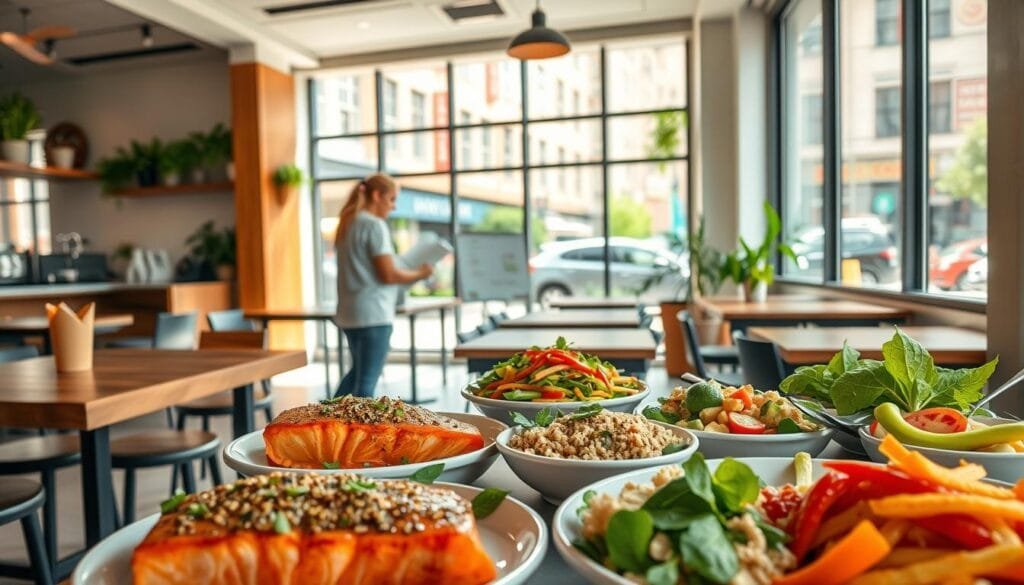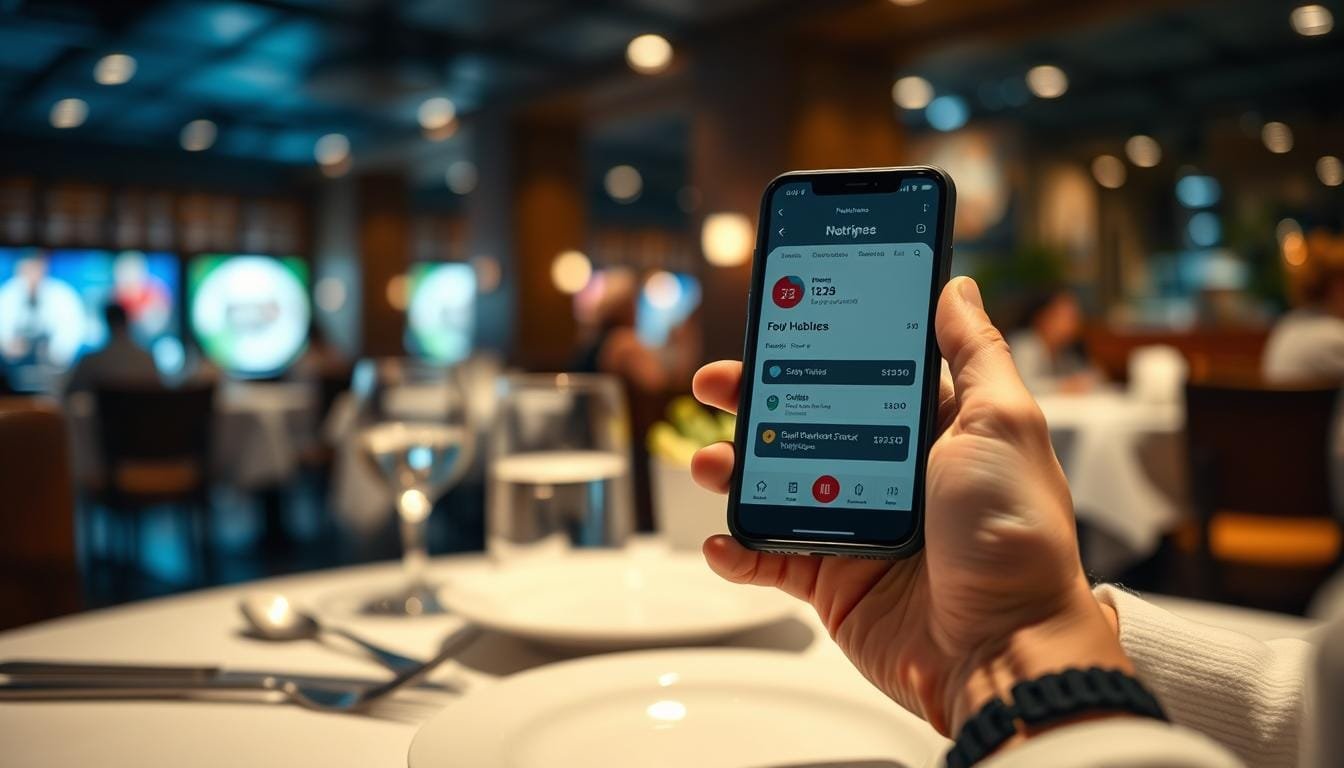How to track macros when eating out can be tricky, but with the right approach, you can enjoy dining out while staying on track.
Imagine you’re at a restaurant, eyeing a grilled chicken sandwich. You know it has about 25-30g of protein. The bun adds roughly 35g of carbs. But what about the hidden fats?
That’s where the challenge begins. Yet, with smart choices and know-how, you can navigate any menu while meeting your nutrition goals.
Let’s explore how to track macros when eating out, including estimating portions, understanding restaurant nutrition info, and making informed choices that fit your dietary needs. These tips will help you enjoy eating out without derailing your nutrition plan.
Key Takeaways
- Macro tracking allows flexibility while maintaining nutritional balance
- Understanding portion sizes is crucial for accurate macro tracking
- Restaurant nutrition information can be a valuable resource
- Pre-planning and smart ordering strategies help maintain macro goals
- Balancing macros throughout the day can offset higher-calorie restaurant meals
- Consistency in tracking, even with small errors, leads to long-term progress
Understanding Macro Tracking Basics
Macro tracking helps achieve health and fitness goals. It lets us make smart choices about our diet. We can do this by understanding macronutrients and their roles.
What are Macronutrients?
Macronutrients are the main parts of our diet. They include protein, carbohydrates, and fats. Each one does something special for our body.
- Protein: 4 calories per gram, essential for muscle growth and repair
- Carbohydrates: 4 calories per gram, our body’s primary energy source
- Fats: 9 calories per gram, crucial for hormone production and nutrient absorption
Why Track Macros?
Tracking macros helps us improve our nutrition. It shows us what we’re eating. We can then make changes to reach our goals.
Setting Your Macro Goals
To set macro goals, think about your weight and how active you are. Also, consider what you want to achieve.
A typical macronutrient ratio might look like this:
| Macronutrient | Percentage of Daily Calories |
|---|---|
| Carbohydrates | 45-65% |
| Protein | 10-35% |
| Fats | 20-35% |
For a 2000-calorie diet with a 50/30/20 split, aim for 250g of carbs. You’d also need 150g of protein and 45g of fat daily.
These numbers can change based on what you need. Adjust them to fit your own goals.
How to Track Macros When Eating Out
Tracking macros while dining out can be tricky. But with the right approach, you can stay on target. Let’s explore ways to keep your macro goals in check.
Pre-planning Your Restaurant Meals
Many restaurants now share nutrition info online. This helps you plan meals ahead of time. You can make smart choices that fit your macro needs.
Using Tracking Apps and Tools
Macro tracking apps have changed how we monitor our eating. These tools offer large food databases for easy meal logging. Apps like MyFitnessPal or LoseIt! help you track macros accurately.

Estimating Portion Sizes
Guessing portion sizes is key when exact measures aren’t available. Restaurant portions are often bigger than standard servings. Try packing up half your meal right away.
This cuts calories and saves food for later. It’s a simple way to control your intake.
Reading Restaurant Nutrition Information
Restaurant nutrition info is gold for macro tracking. Look for grilled or baked dishes instead of fried ones. Watch out for hidden calorie sources like dressings.
Ask for dressings on the side to control your intake. This helps you stay within your macro limits.
Use these tips to enjoy eating out while tracking macros. Aim for 90% plan adherence for great results. This allows for occasional treats too.
Smart Restaurant Ordering Strategies
Tracking macros while dining out can be challenging. Here are some tips to help you make healthy choices at restaurants. These strategies will guide you in finding macro-friendly meals.
Choose protein-rich dishes like grilled chicken, lean steak, or fish. At Chick-fil-A, try the Grilled Chicken Sandwich with 30g of protein. For fewer carbs, opt for their 12-piece Grilled Nuggets with 34g of protein.
Replace fries with veggies or a salad. The Chick-fil-A Superfood Side (Large) has 23g carbs and 8g fat. This swap can greatly reduce your meal’s calories.

Watch out for hidden calories in dressings and sauces. Ask for these on the side to control how much you use. Many people forget about these extras, which can add up fast.
Pay attention to portion sizes. Restaurant servings are often too big. Share a meal or ask for a to-go box right away.
| Restaurant | Meal | Protein | Carbs | Fat |
|---|---|---|---|---|
| Chick-fil-A | Grilled Chicken Sandwich | 30g | 40g | 5g |
| Chick-fil-A | 12-piece Grilled Nuggets | 34g | 6g | 5g |
| Chick-fil-A | Superfood Side (Large) | 4g | 23g | 8g |
| Outback | Center Cut Sirloin 6oz | 38g | – | 7g |
| Denny’s | “Fit Slam” | 24g | 54g | 10g |
Common Restaurant Meals and Their Macro Breakdowns
Knowing restaurant meal macros helps you stay on track with your nutrition goals. Let’s look at popular dishes to help you make smart choices when eating out.
Popular Protein Options
Protein options vary in their nutrient content. Chili’s Smoked Bone-In BBQ Chicken Breast has 43g of protein and 360 calories.
Chick-fil-A’s Grilled Chicken Sandwich offers 29g of protein at 310 calories. Both are tasty choices for protein-packed meals.
Check This:
- How to Eat Healthy Eating Out: Savvy Tips and Tricks
- 10 Effective Tips on How to Follow a Diet Without Cheating
Carbohydrate Considerations
Carb choices can greatly change your meal’s macro profile. Chili’s Fresco Salad without dressing has only 4g of carbs.
Their Margarita Grilled Chicken dish includes 64g of carbs. Pick wisely based on your carb needs.
Hidden Fat Sources
Watch out for hidden fats in restaurant meals. Olive Garden’s Grilled Chicken Parmigiana has just 9g of fat.
Shake Shack’s Single Hamburger contains 21g of fat. Be aware of these differences when ordering.
| Restaurant Item | Calories | Protein (g) | Carbs (g) | Fat (g) |
|---|---|---|---|---|
| Chili’s Smoked BBQ Chicken | 360 | 43 | 20 | 12 |
| Chick-fil-A Grilled Sandwich | 310 | 29 | 36 | 6 |
| Chili’s Fresco Salad (no dressing) | 70 | 2 | 4 | 5 |
| Olive Garden Grilled Chicken Parm | 760 | 75 | 54 | 9 |
| Shake Shack Single Hamburger | 385 | 24 | 25 | 21 |
Restaurant-Specific Macro Guidelines
Some restaurants offer more macro-friendly options than others. Chipotle is great for its customizable menu, making macro tracking easier.
Steakhouses, sushi spots, and organic salad places are often good for macro-conscious diners. These eateries offer more control over your meal’s nutrients.
Essential Tips for Maintaining Macro Balance
Balancing macros while eating out can be challenging. Here are strategies to help you stay on track. You can still enjoy meals out while meeting your nutrition goals.
Pre-meal Planning
Plan your meals when dining out. Save up to half your daily calories for restaurant meals. Focus on carbohydrates and fats.
Adjust your macros using a 2:1 ratio of carbs to fats. This helps maintain your total calorie targets.
Portion Control Techniques
Restaurant portions have grown larger over time. Use hand measurements to estimate serving sizes when scales aren’t available.
Practice mindful eating by stopping at 80% fullness. This helps you avoid overeating during meals out.
Dealing with Hidden Calories
Hidden calories are common in restaurant meals. Dishes often have more carbs and fats than homemade versions.
When tracking macros, log individual ingredients rather than general terms. This helps avoid calorie count discrepancies.
- Choose tomato-based sauces over creamy ones for pasta dishes
- Opt for broth-based soups instead of cream-based varieties
- Request dressings and sauces on the side
- Be cautious with deep-fried options and sushi rolls with tempura
One indulgent meal won’t ruin your nutrition goals. Use these strategies to maintain macro balance while dining out.
Conclusion
Macro tracking while dining out offers benefits for flexible dieting and sustainable nutrition. It helps us make informed choices that align with our health goals. Understanding macronutrients and their caloric values is crucial for this approach.
The January app, with its vast food database, can assist in this journey. However, food labels and restaurant menus can have a 20% margin of error in calorie counts.
Macro tracking improves nutritional awareness but has its challenges. Most restaurant meals exceed 1,200 calories, making accurate tracking difficult. The balanced plate concept can guide our choices.
Consistency in tracking, not perfection, is key to long-term success. This approach allows for daily and weekly variations without significant weight changes. It’s a flexible way to maintain nutritional balance.
Source Links
- https://evidation.com/blog/track-macros-when-eating-out – How to track macros when eating out: a how-to guide
- https://www.coachmymacros.com/macro-diet-blog/how-to-track-macros-when-eating-out – How to Track Macros When Eating Out — Coach My Macros

